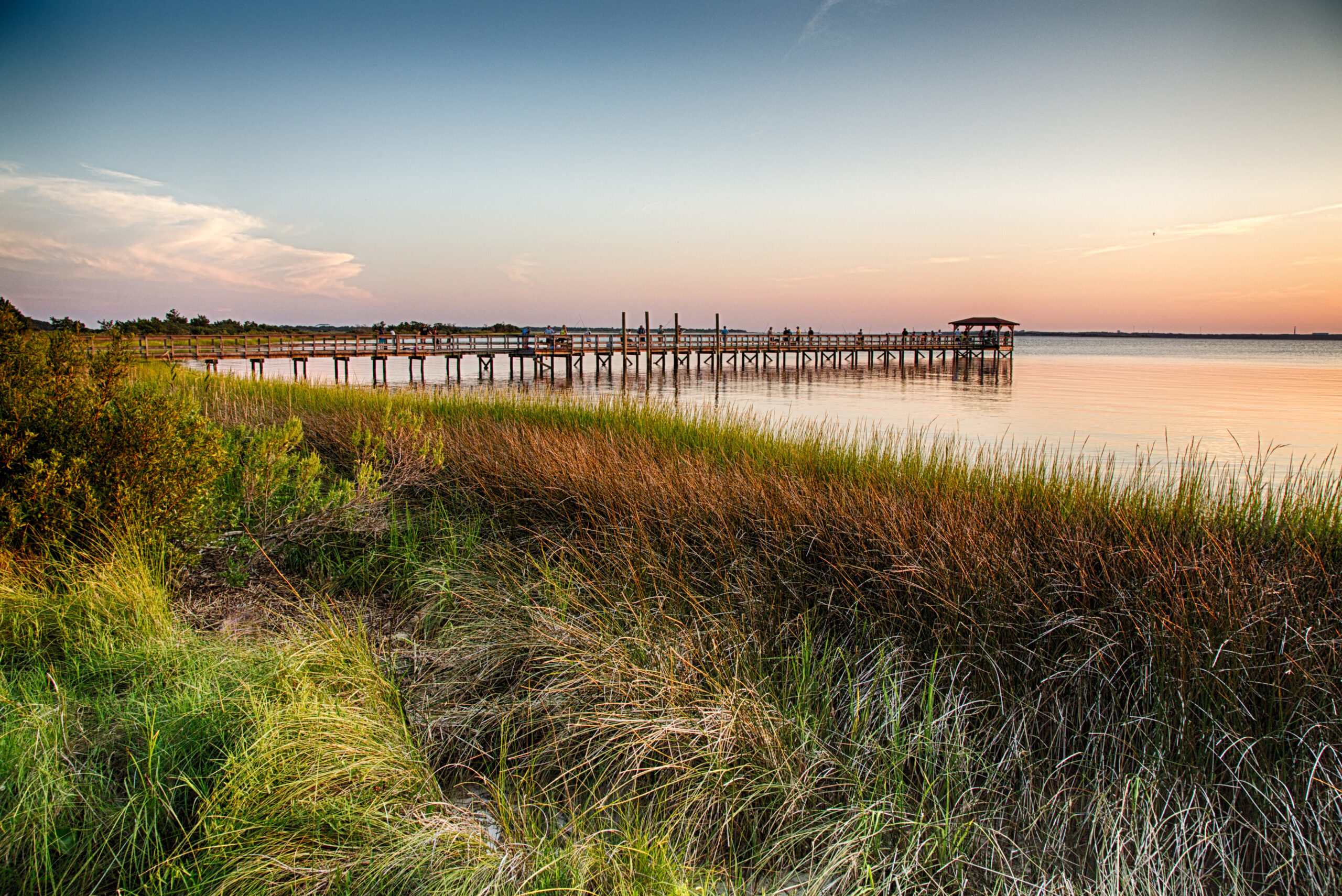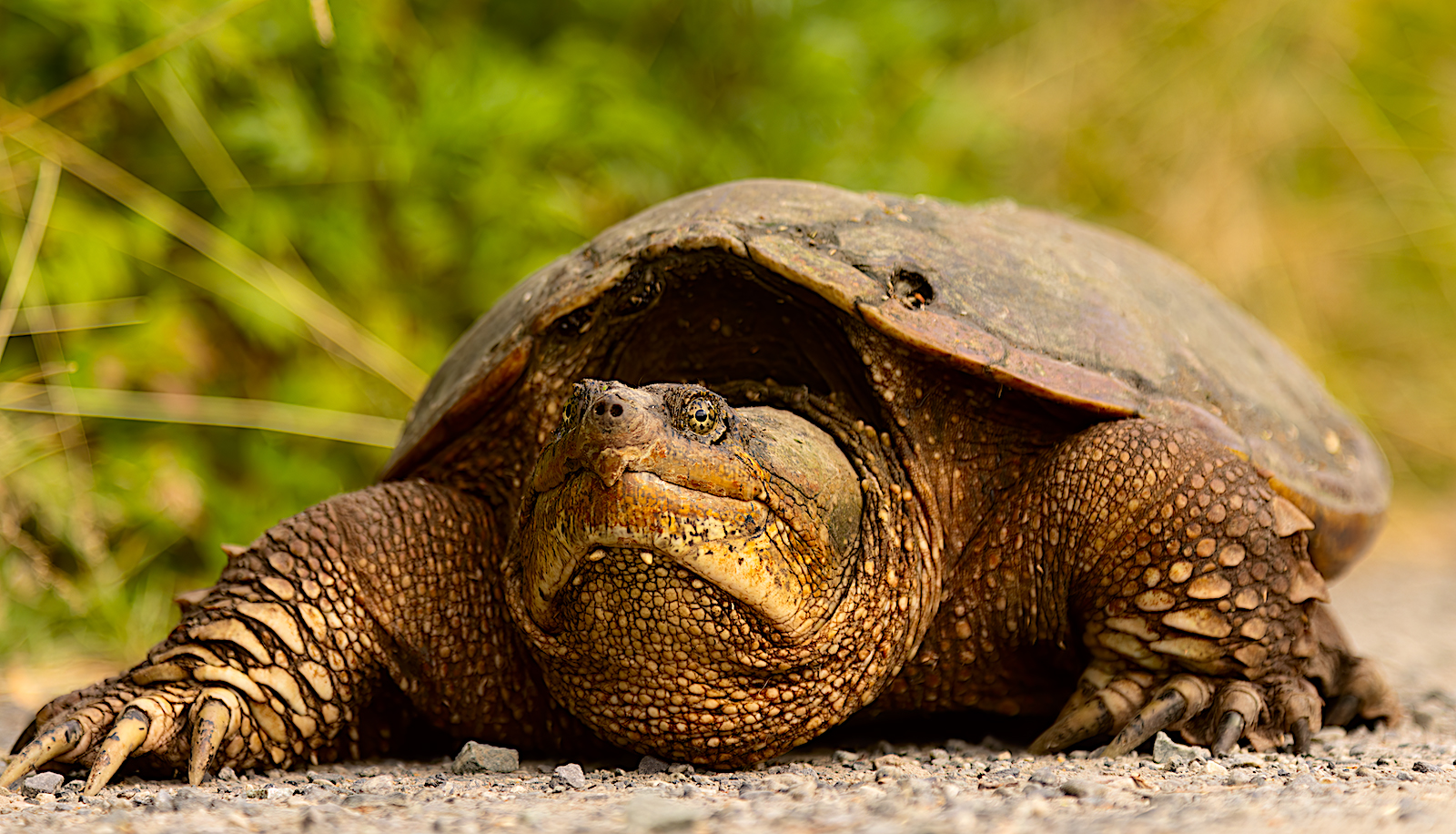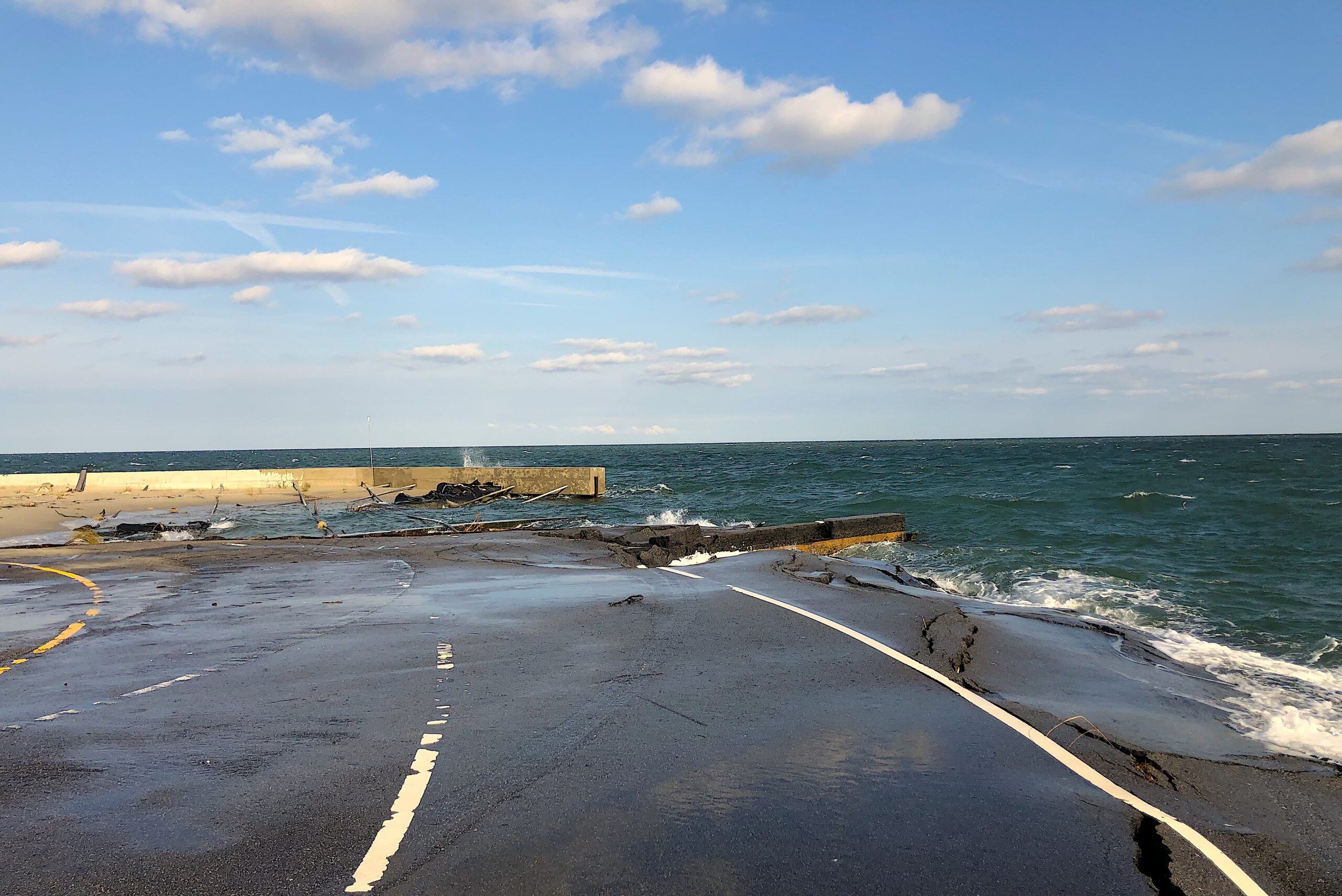MAPPING THE OVERLAP: Terrapins & Crab Pots in the Lower Cape Fear Region

Visitors unfamiliar with Masonboro Island may wonder what planet they are on when a hooded figure in hip-high boots emerges out of the fog with a large antenna. A seasoned visitor would know it’s only University of North Carolina Wilmington graduate student Leigh Anne Harden — known by some locals as the “turtle girl” — out on a chilly spring morning to track and observe her reptilian research subjects.
The antenna Harden holds is connected to a portable receiver strapped to her shoulder. She turns from side to side, listening intently for a faint beep that will indicate that she is on the right track.
She attached transmitters and temperature loggers to several diamondback terrapins in summer 2008 and has been following them to discover their biological characteristics and how they are using their habitat.
The diamondback terrapin, or Malaclemys terrapin, is a species of turtle native to brackish waters along the East and Gulf coasts. The Carolina diamondback terrapin, or Malaclemys terrapin centrata, is the subspecies found in North Carolina.
In late October or early November through early March, these terrapins hibernate, burying themselves under the mud to keep warm.
“If the antenna is totally buried or submerged, we won’t be able to pick up the signal,” Harden says.
She had hoped to find some terrapins swimming, but they are still lying low due to the cold water temperatures. Harden rotates through several channels on her receiver — each one representing a terrapin she is tracking — until she hears the characteristic beep and heads off through the muddy marsh in what she hopes is the right direction.
Trying to find a 7.5-inch green-and-brown camouflaged animal on an island covered with thick mud and dense marsh grass is no easy task.
Harden proves to have a special knack, as well as patience and determination. Over the course of the foggy morning, she and UNCW marine biology undergraduate Tim Burns follow the signal until they find two terrapins barely visible, with only their thin black transmitters and the tops of their heads peaking above the mud’s surface.
But the search doesn’t end with locating the turtles. The true purpose of Harden’s research — and the focus of an ongoing state-funded project — is to discover overlaps between terrapin habitat and the blue crab fishery in the lower Cape Fear River.
As well as recording data about the turtles, Harden checks the area for crab pots and records their location, depth and the crabber’s name if the buoy is marked. She also talks to crabbers about their catch to determine the productivity of the blue crab fishery in areas where it overlaps with terrapin habitat.
The Blue Crab and Shellfish Research Program (BCSRP) — funded by the N.C. General Assembly and coordinated by North Carolina Sea Grant — is providing grant money for the project.
SPECIES OF CONCERN
Diamondback terrapins are identified as a “species of special concern” in North Carolina. This designation means that there are no formal regulations for protecting the species, but that populations are declining at a rate that may require conservation efforts.
Some worrisome trends are noted in a 2007 report by researchers who analyzed two decades of diamondback terrapin data from tidal creeks near Kiawah Island, S.C. Demographics in the study area were shifting towards high female-to-male ratios and populations were becoming increasingly dominated by older and larger individuals.
Crabbing pressures may be contributing to these trends according to the South Carolina report and other research cited by the terrapin project team.
Males — which are considerably smaller than females — and immature females are more likely to be captured in crab pots because they are smaller and fit through trap openings. Without the ability to surface for air, the terrapins will drown within 45 to 300 minutes. Mortalities of these males and young females could lead to the older, larger, female-dominated populations some scientists are seeing.
But Harden emphasizes that most southeast studies have taken place in South Carolina and Georgia. Thus, her focus is to learn specifics about local populations in North Carolina.
The 2004 N.C. Blue Crab Fishery Management Plan (FMP) identifies unintended capturing of diamondback terrapins as a relevant issue, but states the need for more research prior to passing any new regulations on crabbing practices.
“There has been a lot of qualitative documentation of high mortalities due to crab pots, nest predation, vehicle strikes, habitat destruction and alteration, but very few quantitative long-term studies that document declines in populations,” Harden says.
Some past North Carolina studies have tested methods of equipping pots with excluder devices to limit terrapin bycatch. However, Marc Turano, Sea Grant’s mariculture and blue crab specialist, explains that regulatory agencies won’t have enough information to require such devices until more general characteristics about terrapin populations and migratory behavior are understood.
“We first need to find out how many terrapins there are, where they are, and where they travel.”
The research team is addressing several action items presented in the FMP with this project. Topics include population distribution, interaction between terrapins and the blue crab fishery, and making bycatch prevention information available to fishermen.
“Fishermen already know about terrapins,” but their local knowledge needs to be documented, explains Amanda Southwood, a UNCW assistant professor and principal investigator on this project. Some “simple changes in fishing efforts” — like moving pots further from shores where males and juveniles tend to congregate — may help to reduce terrapin mortalities, she adds.
Southwood has participated in several BCSRP and N.C. Fishery Resource Grant Program (FRG) projects focusing on various turtle species.
Jeff Wolfe, also a principle investigator on the project and captain of Seahawk Inshore Fishing Charters, says terrapin bycatch is not a big problem in the study region. In the past, Wolfe worked as a commercial fisherman, catching everything from crabs to clams and oysters. He also has served on various state fishery advisory committees.
“Hopefully, if their pots get turtles in them, fishermen won’t go to the same place again,” Wolfe says.
Turano says several of the commercial crabbers who set pots in the area targeted by the study have already dealt with the issue.
“Many crabbers here already set their pots farther away from shore,” Turano says, explaining that concern over terrapin bycatch in North Carolina may be fueled by more serious problems in South Carolina and Georgia.
Turano says that “ghost pots” — abandoned or lost pots that may continue to trap aquatic life — and pots that are set off docks recreationally and then forgotten may present a greater threat to diamondback terrapins.
Sometimes terrapins are especially populous in “pockets” that pose a problem for fishermen. Some regulations in specific areas might be useful to protect those populations, Wolfe notes.
Such pockets are what the team hopes to find. The team surveyed in the sounds and creeks along the Intracoastal Waterway in New Hanover County. The highest densities of terrapins have been in two small coves — behind Masonboro and Figure Eight islands.
SPRING SEINING
Harden, Wolfe and Southwood are beginning this second project year the same as the first — by selecting key study sites.
“We scope out an area and see how many heads we see pop up,” Wolfe says. These visual head counts usually indicate good places to seine.
On their first seining trip this year, they caught 11 terrapins. Each terrapin they catch is examined and marked on its shell with three unique notches. Researchers record head width, shell length, shell width, shell height and mass of each terrapin. By notching the outer shell the team ensures that these terrapins will be recognized if they are caught again.
Some terrapins at each study site get radio transmitters, so that Harden can track them throughout the year.
Tracking them provides data on: seasonal movements of terrapins within and between study sites; important winter hibernation locations; differences in movement patterns between males and females and between mature and immature terrapins; and preferences in habitat such as water depth, water temperature and amount of vegetation.
The team attaches transmitters to the terrapins’ shells with a fast-drying marine epoxy and releases them within an hour of capture at the same site where they are caught.
Transmitters on the large females may last up to 18 months. Harden plans to retrieve the transmitters before the end of their lifespan. Any she cannot locate will fall off when the terrapins shed their scutes — individual bony scales on the shell that are shed several times throughout the year.
In 2008, the team caught 22 terrapins at Figure Eight Island and 19 at Masonboro Island. Out of those caught, Harden is tracking 15 from Figure Eight and 14 from Masonboro.
Seventeen of these terrapins also were equipped with temperature loggers. These micro-data loggers record temperatures every 30 minutes. After about six months, the loggers fill up with data, and the team retrieves them and replaces them with new ones.
Temperature information can help the team to get “some fine-scale features on their thermal ecology,” Southwood says. Matching temperatures from the logger to surface mud or water temperatures collected at the sites can reveal patterns of seasonal movement and behavior.
Two local crabbers — Sammy Corbett and Scott Rader — will provide Harden with data on their crab catch per unit effort (CPUE). Corbett also helped her find terrapin populations and indicated locations where he had caught the most terrapins in his pots in past years.
The project team is expanding the study region farther south toward Carolina Beach and Fort Fisher this year, as well as continuing to follow Year One terrapins from Masonboro and Figure Eight islands.
Extending the study sites will help the team gather broader information on terrapin abundance and distribution, Southwood says.
Although Harden says “it is too early to say anything definite about terrapin populations in this area,” she did find some distinct differences between the terrapin populations identified at Figure Eight Island versus Masonboro Island.
“The Figure Eight population seems to be young,” Harden explains. “We have been catching a lot of young males and females.”
The team uses the common method of counting the annuli or “rings” found on the underside of the shell to estimate approximate ages of terrapins — similar to aging a tree by its growth rings. One ring usually corresponds to one year, although terrapins can develop more than one annuli per year if growing substantially, explains Harden.
Out of the four times the team has seined at Figure Eight, most of the terrapins caught have been under eight years old, with a relatively equal split between males and females. But at Masonboro Island, the three times they have seined, they have repeatedly caught mainly the same older females.
“This might be indicative of historical crabbing pressures or nest predation by foxes and raccoons on Masonboro Island,” Harden says. “Or just fewer young terrapins colonizing the cove.”
She explains that Masonboro Island’s high levels of human activities in the cove from spring to fall might deter young terrapins. Masonboro Island is an uninhabited National Estuarine Research Reserve, but is accessible to the public and is a popular destination for camping, boating and surfing.
SHARING RESULTS
At the end of this two-year project, the team plans to share their results with local management agencies including the N.C. Marine Fisheries Commission, the N.C. Division of Marine Fisheries (DMF), the N.C. Wildlife Resources Commission and Sea Grant. They will also present results at a national scientific conference, submit them for publication in a scientific journal and post them on Southwood’s UNCW Web page.
It also falls under Harden’s role as co-chair of the southeast chapter of the Diamondback Terrapin Working Group to share local research results — including the results of this project — with other regional groups. The Diamondback Terrapin Working Group is a collaboration of individuals from academic, scientific, regulatory and private institutions and organizations working to promote conservation of diamondback terrapins and their ecosystems throughout their range.
“This project will either prove there’s an issue here or that it’s not the problem it is in other states,” Turano says. Either way, results will contribute to the next revision of the N.C. Blue Crab FMP, which is scheduled to begin this year.
If terrapin bycatch is determined to be an issue needing regulation, the FMP may require fishermen to equip crab pots with excluder devices. Some northeast states currently require these devices, which are based on shell height.
Turano expresses hope that simple adjustments in fishing practices, such as moving pots away from areas with greater interaction, could be adopted without requiring the use of exclusion devices. Or, if the devices are considered and required, that regulations target pots set in areas where terrapin bycatch is a documented problem.
However, monitoring and enforcement become more difficult when regulations vary by area, Turano adds.
Any revisions to the blue crab FMP relating to terrapin interactions also will be based on data from other states and from DMF studies on crab pot biodegradable escape panels.
For more information about BCSRP, go online to ncseagrant.ncsu.edu and follow links to “Research” and “Blue Crab & Shellfish Research.” To learn more about the Diamondback Terrapin Working Group, visit the Web: www.dtwg.org.
This article was published in the Summer 2009 issue of Coastwatch.
For contact information and reprint requests, visit ncseagrant.ncsu.edu/coastwatch/contact/.
- Categories:


